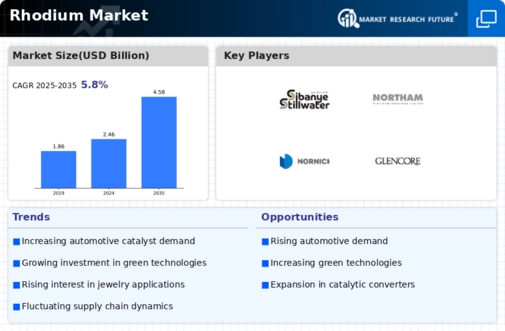Leading market players are investing heavily in the research and development in order to expand their product lines, which will help the Rhodium market grow even more. Market parties are also undertaking a variety of strategic activities in order to expand their footprint, with important market developments including mergers and acquisitions, new product launches, contractual agreements, higher investments, and collaboration with other organizations. To expand and survive in the more competitive and rising market climate, the Rhodium industry must offer cost-effective items.
Manufacturing locally to minimize the operational costs is one of the key business tactics used by the manufacturers in the Rhodium industry to benefit the clients and grow the market sector. In recent years, the Rhodium industry has offered some of the most significant advantages to several industries. Major players in the Rhodium market, including Sibanye-Stillwater, Anglo American Platinum Limited, Sibanye Gold Limited, Russian Platinum, Sharretts Plating Company, Northam Platinum, DF Goldsmith, Norilsk Nickel, Vale SA, Glencore and others, are attempting to raise market demand by investing in research and development operations.
Sibanye-Stillwater is a leading precious metals mining company headquartered in South Africa. Founded in 2012, the company has grown to become one of the world's largest producers of gold and platinum group metals (PGMs). Sibanye-Stillwater operates a diverse portfolio of mining assets, including underground and surface gold mines, as well as PGM mines in South Africa and the United States. The company is known for its commitment to safety, environmental sustainability, and responsible mining practices. In November 2023, mining giant Sibanye-Stillwater and chemical company BASF announced a strategic partnership to develop and commercialize sustainable rhodium recycling technologies.
This collaboration aims to improve the efficiency of rhodium recovery and reduce its environmental footprint.
Anglo American Platinum Limited is a globally renowned mining and natural resources company with a primary focus on platinum group metals (PGMs). Headquartered in Johannesburg, South Africa, the company is a subsidiary of the larger Anglo American plc, a multinational mining conglomerate. Anglo American Platinum is the leading producer of platinum, palladium, rhodium, iridium, ruthenium, and gold, which are essential components in different industrial applications, including catalytic converters, electronics, and jewellery.
Anglo-American Platinum and Sibanye-Stillwater, these two major platinum producers, announced a collaboration in October 2023 to explore opportunities for joint ventures in the exploration, mining, and refining of platinum group metals, including rhodium.







Leave a Comment